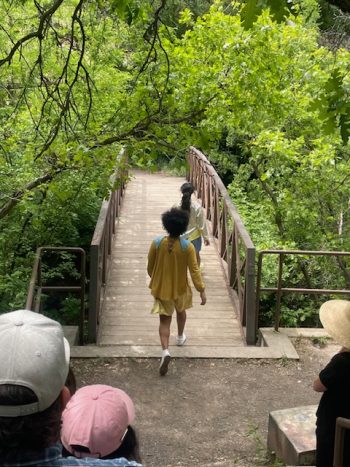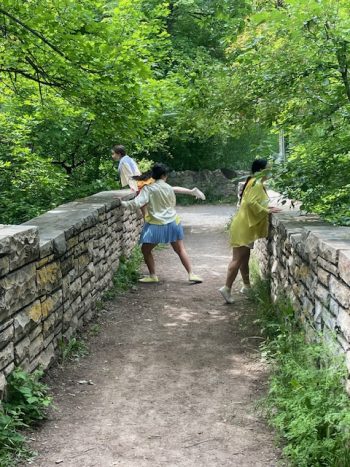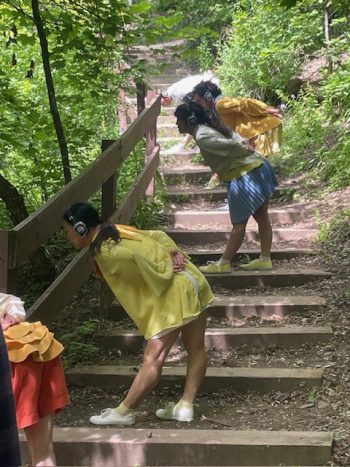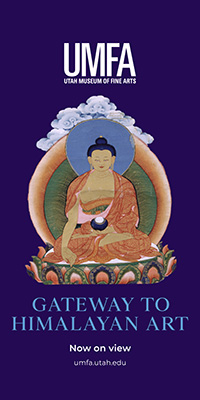
Movement unfolds in relation to place in Mitsu Salmon’s Feathered Tides, with dancers interacting directly with the natural and interpretive landscape.
“Birds are really reliant on the Great Salt Lake,” says Mitsu Salmon, director of immersive dance experience Feathered Tides. Centered around native birds and bringing awareness to the drying of the Great Salt Lake, Feathered Tides takes viewers on a journey into all levels of emotion through varying media, including dance and music composition. One of the most imperative elements of Feathered Tides is its site specificity: it was specifically choreographed and envisioned in the Miller Bird Sanctuary, which is home to a variety of bird species reliant on the Great Salt Lake. “Especially in the pandemic, I would walk there almost daily,” comments Salmon, where plans for Feathered Tides came into conception roughly a year ago. “The initial impulse [for Feathered Tides] was the place, falling in love with the Miller Bird Sanctuary,” Salmon says.
Feathered Tides is one of 12 initiatives currently supported by Wake the Great Salt Lake, a series of temporary public art projects designed “to educate and inspire residents and visitors about preventing the decline of the Great Salt Lake,” according to Wake the Great Salt Lake. “Without action, Great Salt Lake’s collapse would have major ecological and economic impacts on the city, state, and region.” Organized by the Salt Lake City Arts Council, with the support of the Salt Lake City Mayor’s Office, the project was funded by Bloomberg Philanthropies’ Public Art Challenge with the largest single grant the Arts Council has ever received. Rather than highlighting depressing statistics, artists have the opportunity through the grant to inspire our community to take vital and needed action to protect our landscape.
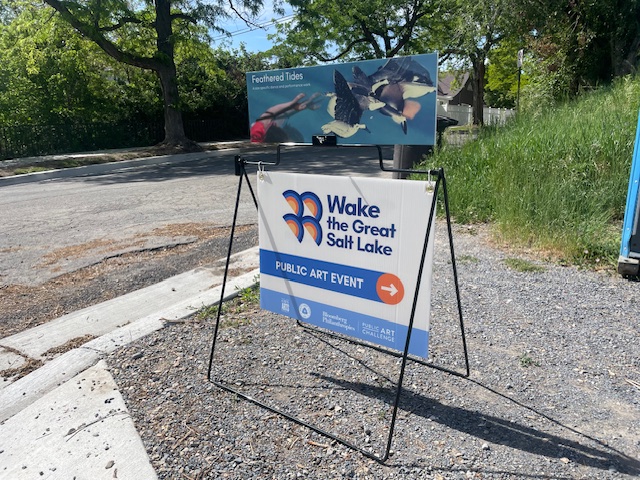
Signage for Feathered Tides, part of the Wake the Great Salt Lake initiative, welcomes viewers to an experience at the intersection of art and ecology.
Feathered Tides includes six dancers, who were vital to the performance and its process of creation. “It’s very collaborative…all of the dancers are incredible,” says Salmon. Starting with personal research, Salmon would bring key findings to rehearsals along with videos of local birds in motion. After a discussion of the species, Salmon would share prompts with the dancers who would then choreograph their own getsures based on thier explorations. Salmon then used the dancer’s movements, building them into the overall choreography. “Each piece varies from mostly theirs to mostly mine”, says Salmon, sharing that viewers can find that more of the solos are dancer-led while much of the corps or group dancing is choreographed by Salmon. “I don’t say I’m the choreographer, I say I’m the director… so much comes from the dancers even though I’m shaping it…it wouldn’t happen without them.”
The performance itself is an immersive hour in nature, venturing into a deep exploration of Utah’s native birds and their reliance of Salt Lake City’s namesake. The beginning of the performance is soundless, without the use of the provided headphones, begging viewers to listen to the rush of the river and wind blowing through the leaves while the dancers emerge from the wooded areas. A mixture of classical and contemporary movements, the choreography is birdlike and flowy, paired perfectly with the lush landscape. The audience follows the river in the round trip through the reserve as it flows out to the Great Salt Lake, further amplifying the performance’s goals and greater callings. Audience members are provided with binoculars, allowing them to observe both the show and surrounding birdlife, creating the immersive feeling of being part of the scene. Further along in the performance, viewers are urged to don their provided headphones to experience a custom track, composed by Simon Briggs, Kiku Hibino and Peter Speer, backing the dancers. The track includes cues for the audience, questions to ponder, music to accompany the dancers, and retellings of specific species such as the emotional exploration into the pelican, an endangered species. Dancers use varying materials to contrast the thick foliage and pastel costuming, designed by Virginia Broyles, creating starkness in the soft landscape. As viewers complete the full circle of the performance, they begin to question the idea of home, and where home truly is for ourselves and the nature that surrounds us.
A performance of this scale in such a volatile space did not come without its inherent challenges. Although Salmon has had experience with outdoor performances in the past, the Miller Bird Reserve brought unique challenges, designed to protect the habitat, such as no amplified sound and no large gatherings. “It was a good challenge,” comments Salmon. Indeed, such limitations meant to protect the wildlife, the center of the performance, allowed for new opportunities to emerge. No sound amplification paved the way for the creation of the custom audio backtracking and use of headphones. The prohibition of large gatherings allowed for not only more intimacy in groups, but more space for the dancers to rush past audience members and new ares of exploration in the reserve. “There was a lot of possibility”, says Salmon, yet the result is a highly intentional performance, with every element calculated to serve the birds.
Performances of Feathered Tides took place over two weekends in late May, addressing issues that are both immediately urgent and enduring. The piece asks its audience, “What next?” For Salmon, the next step is preservation—not only of the lake, but of the work itself. In the next year, Salmon hopes to preserve the work in video format or possibly a book in the coming year, extending its reach and making its message last.
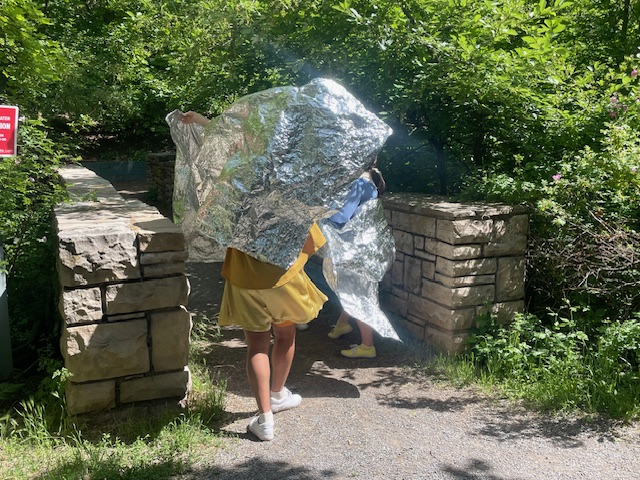
Mitsu Salmon: Erosion and Becoming opens at Finch Lane Gallery, in Salt Lake City, June 17 and continue through July 25.
All images courtesy of the author.

Avery Greig always has something to contribute. Whether lost in an art exhibition, meandering in downtown salt lake, or haunting a museum, she always has something to say when it comes to art. With her BA in Art History from the University of Utah, she loves sharing her passions for art and writing wrapped up in one.
Categories: Dance

